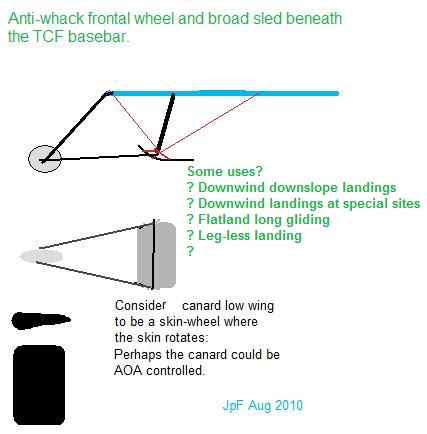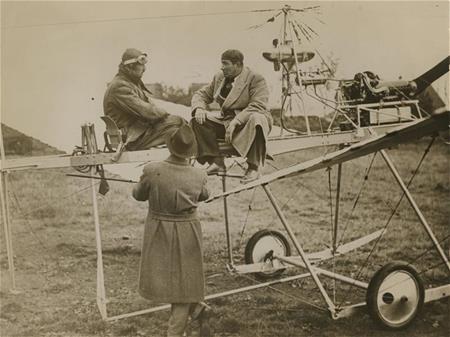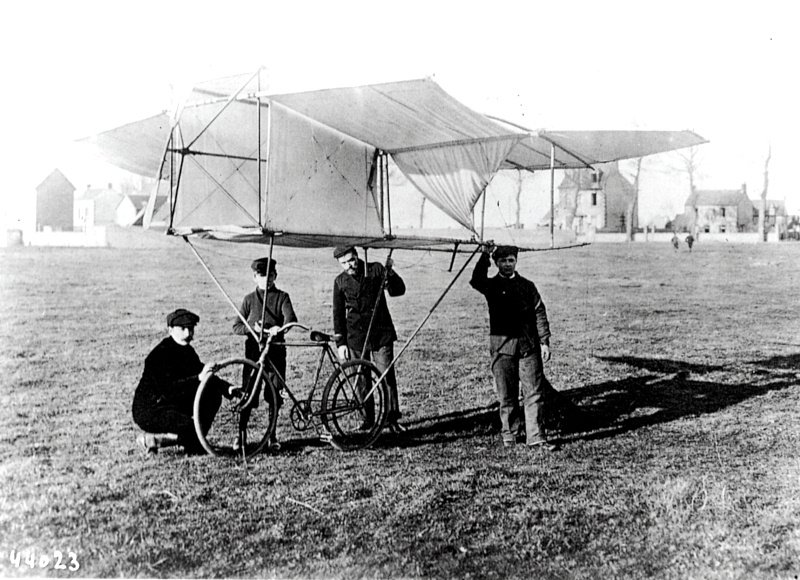Reflecting my earlier attention on topic at another forum:
=================================================
Have fun Tue, Aug 10 2010, 10:43:45 pm
Comments are invited, have fun:

Edit: Aug. 23 :: See later post for deployable alternate version.
EDIT: A cousin topic thread was opened in 2012:
http://ozreport.com/forum/viewtopic.php?t=28102=======================
Christian Williams was first to reply:
But--why?
If planning to land frequently downslope or downwind on a known strip, wouldn't a good set of basetube wheels work?
Who would plan to land downslope or downwind into rough terrain? So why carry around all this extra stuff?
========================
Re: Have fun Fri, Aug 13 2010, 2:34:22 am
(quoting entire message by Christian Williams, right above)
Christian,
Good questions.
You have started the planning space. It may be great fun to comprehensively find planned scenes and examine the pros and cons in each that might seem interesting.
And you anchor the big "Why?" Having fun with that might spark findings of interest. I am guessing there will be many responses to your "why?"
In support of your contribution, I bring in the whole universe of "unplanned" landing experiences; and the planned unplanned space also.
The drawing was just edited a bit for spelling and slight expansion of text. I was assuming without stating that in the skyview of the one version: the upper edge of the tetrahedronic cage from nose to wheel (or frontal canard wing) is not drawn in order to given emphasis to the two elements going to the basebar region; the sideview shows the edge that is neglected in the skyview.
And perhaps add to the party:
== Consider in the fun the region of flight for "flatland long gliding" (FLG) where the pilot aims not to use legs in the landing operation.
http://www.hanggliding.org/wiki/Ground-effect_gliding == Consider in the fun the possibilities of deploying elements from low-drag stowing of the elements.
== Consider examining all the wheels that have been in our hang gliding experiences; explore aims and results; then examine the suggestive play in the same scenes.
== Consider each whack that has occurred and explore some what-ifs relative to the shown play: either the frontal wheel-and-TCF sub sled or the frontal canard sled wing-and-TCF sub sled.
== Consider legless pilots.
== Consider fine defects in landing turfs (planned or unplanned)
== Conder Jonathan Dietch's recent desert downwind downslope video.
A Hair Raising Fire Road Landing [Posted: Mon Apr 26, 2010 9:42 pm]
Christian, you initiate another dimension in asking about "carry around all," etc. When would it be "extra" and when would it be "glad I have it for this activity!"
Just how might one build and handle various versions of the suggested elements?
Worth?
Investment level?
Secondary uses of the elements? The TCF region sled could perhaps be explored as a wing; and its upper surface might be considered as instrument-panel screen. I am just at the beginning of the party.
What, where, why, when, who, precise design, how, secondary uses of elements, results, experiences, etc. ?
Some rough preliminaries are being collected:
http://www.energykitesystems.net/TCF/index.html=======================
Christian Williams wrote:But--why?
If planning to land frequently downslope or downwind on a known strip, wouldn't a good set of basetube wheels work?
Who would plan to land downslope or downwind into rough terrain? So why carry around all this extra stuff?
Christian,
Good questions.
You have started the
planning space. It may be great fun to comprehensively find planned scenes and examine the pros and cons in each that might seem interesting.
And you anchor the big
"Why?" Having fun with
that might spark findings of interest. I am guessing there will be many responses to your "why?"
In support of your contribution, I bring in the whole universe of "unplanned" landing experiences; and the planned unplanned space also.
The drawing was just edited a bit for spelling and slight expansion of text. I was assuming without stating that in the skyview of the one version: the upper edge of the tetrahedronic cage from nose to wheel (or frontal canard wing) is not drawn in order to given emphasis to the two elements going to the basebar region; the sideview shows the edge that is neglected in the skyview.
And perhaps add to the party: == Consider in the fun the region of flight for "flatland long gliding" (FLG) where the pilot aims not to use legs in the landing operation.
http://www.hanggliding.org/wiki/Ground-effect_gliding == Consider in the fun the possibilities of deploying elements from low-drag stowing of the elements.
== Consider examining all the wheels that have been in our hang gliding experiences; explore aims and results; then examine the suggestive play in the same scenes.
== Consider each whack that has occurred and explore some what-ifs relative to the shown play: either the frontal wheel-and-TCF sub sled or the frontal canard sled wing-and-TCF sub sled.
== Consider legless pilots.
== Consider fine defects in landing turfs (planned or unplanned)
== Conder Jonathan Dietch's recent desert downwind downslope video.
A Hair Raising Fire Road Landing [Posted: Mon Apr 26, 2010 9:42 pm]
Christian, you initiate another dimension in asking about "carry around all," etc. When would it be "extra" and when would it be "glad I have it for this activity!"
Just how might one build and handle various versions of the suggested elements?
Worth?
Investment level?
Secondary uses of the elements? The TCF region sled could perhaps be explored as a wing; and its upper surface might be considered as instrument-panel screen. I am just at the beginning of the party.
What, where, why, when, who, precise design, how, secondary uses of elements, results, experiences, etc. ?
Some rough preliminaries are being collected:
http://www.energykitesystems.net/TCF/index.html…
Just having fun further: Secondary use idea: Frontal wheel or frontal canard sledding wing or TCF sub-sled-or-wing …these might have a second use of water floating, instrument holding, electric-charge storage, instrument read-out surface, lighting, flight control, …? And such fun would seem to make this situation into a
high hatcase.
And Christian, consider the interface with this topic with your
http://ozreport.com/forum/viewtopic.php?t=21054 Drag-footlanding …inasmuch as the TCF sled/wing can be deployed perhaps to give drag under some control by design; and consider other formats for ground-side of harness toward the same drag matters.
And consider swing-through restraints that might be deployed for a certain landing.
==============================
Jacmac noted:
Re: Have fun Fri, Aug 13 2010, 6:56:34 am
I sure as heck wouldn't try foot lauching that contraption if there was any chance of the nose dipping into terrain.
==============================
Jacmac,
Would you rather the nose dip into the terrain than have an arrangement that rolled/sledded …so that sudden stop would not occur?
Nose dip and sudden stops have killed, broken necks, etc. One of the functions of the arrangement is to keep the nose from dipping into the terrain in special circumstances.
So, I am trying to see what you might be seeing. My phrasing would have: "I sure as heck
would try foot launching with the arrangement, if there was any chance of the nose dipping into the terrain …and so save TCF legs, save neck break, save head hit, and perhaps save from injury or death." So, I hope to understand your perspective better.
JoeF
===========================
Jacmac replies again:
Re: Have fun Fri, Aug 13 2010, 1:45:52 pm
I'm thinking of that front end catching up on boulders, bushes, or tall thick grass immediately in front of the launch.
==========================
Jacmac,
Thanks for clarifying your launching concerns. It is clarifying for me to distinguish launch issues from landing issues. One has more choice and control about the launch point scene than on landing scenes. In the
launch scene in your focus, stowed frontal wheel or stowed frontal canard low wing would seem to be invited; deploy such for landing, if wanted for the impending landing.
Floyd Fronius mentioned to me last Sunday
deployment as something to explore; on his GOAT he has a low frontal skid and rear wheel and does not foot-launch; he uses launch scenes where there is not much chance of catching boulders, bushes, or tall thick grass; on landing he can tolerate pressing down tall grasses and skidding over some sizes of rock (the topic of this thread teases facing sledding over larger rock and more squirrely brush and holes).
The deployed arrangement then becomes a sector of this thread.
How to deploy the devices?
When to deploy the devices?
Affects of stowing and deploying the devices?
====Aug. 22, 2010, furthering:
Alternate fewer-parts stowed and deployable low-nose projective wheel/sled/wing: One piece stows in keel and is deployed forward; the structure of the item is such that as the item comes out of the keel it recalls a curved shape that brings the wheel/sled/wing to a low position ready for functioning as an anti-whack. Choice of tip to wheel or sled or sled-wing might fit particular specialized flying scenes. E.g., the flat field long gliding or "winging" (FLG) might keep the item deployed; whereas deliberate downslope landing following soaring or high gliding might keep the item stowed until on final approach to LZ.

===================
One of the deployable directions is to have the tetrahedronic three frontal edges stowed as such: the staying edge from wheel (or frontal canard wing) to nose might fit inside the keel. And the two edges from the wheel (or frontal low canard wing-sled) could stow up snug to the frontal flying cables.
Thanks,
JoeF
Aug. 17, 2010, furthering:
Post-landing in high winds where one may want to bury the nose does invite quick stowing of the device to allow burying the nose.
JoeF.
====================
C R V responded:
Re: Have fun Mon, Aug 23 2010, 11:44:09 am
The whack, or "WHACK!", as yelled at numerous flying sites throughout the world, is an integral part of hang-gliding and should not be taken away.
From day one, we have been yelling "WHACK!" at our flying buddies…rather than installing unnecessary "accessories" to prevent the whack, we should be researching the history of the whack as well as the yelling of "WHACK!"
Who was the first hang-gliding pilot to yell, "WHACK!"???
That is what we should be concerned.
Do not try to take away the whack in hang-gliding…the whack, or "WHACK!", must be maintained and nurtured for all of us to enjoy.
===================
Mon, Aug 23 2010, 11:51:57 am
Blindrodie notes:
From that Avatar I think we can safely yell, "WHACK - WHACK" Yes the prestigious D Whack or Double down whack. It's rare and deserves a…

====================
Blindrodie wrote:From that Avatar I think we can safely yell, "WHACK - WHACK" Yes the prestigious D Whack or Double down whack. It's rare and deserves a…
Three weeks ago 81 year old veteran hang glider pilot Rome Dodson … after some recovery pause … again flew from Kagel in his specially made harness that does not allow him to use his feet; he lands on wheels. Yesterday he exclaimed one of his pet ideas that would have an explosive device that would go off on the underside of the nose when his wing would whack or come near whacking; the reaction of the explosive would move the nose back up a bit, somewhat like spacecraft control attitude. We talked a bit and I brought up the deployable snout that would keep his wing from whacking. But now with your post Blindrodie, perhaps we could get Rome a sounder that upon touchdown would loudspeak "WHACK, WHACK, WHACK" to delight the LZ crowd at Sylmar. Triple WHACK or TW.
http://energykitesystems.net/RomeDodson/is where some of his colorful history may be gathered (send notes to me, if you wish, on Rome's history).
Editor @ HangGliderMagazine.com
[close spaces] or PM.
=============================
Dayhead noted:
Re: Have fun Mon, Aug 23 2010, 5:40:44 pm
In the original "Whack" video Paul Voight gives Mitch McCaleer the credit for being the first to popularize the term.
Joe, it's good to see someone giving this issue some thought. It has always bothered me that so many serious injuries and even death have occurred as a result of the simple whack.
I broke my back about 2 1/2 yrs ago, I have T6 thru T10 fused with titanium rods on each side of this area. I have to enlist my friends to help carry the folded glider, but I can carry it assembled as the weight is evenly distributed.
The doctor cautioned me regarding shock loads, no jumping down off the tailgate,etc. I've forgotten a couple times and boy do I get reminded very painfully! So I no longer do foot landings, I roll in on wheels. This discourages me from going XC, as I need to land where I know it's reasonably smooth enough for my wheel diameter. So adding a wheel to the nose plate might be a good idea for me.
If I land in a place that "trips" my wheels the nose wheel may prevent a sudden stop. I'm sure that there are a few paralyzed folks out there that wouldn't be if they had had three wheels.
Also, I've often wondered about a restraint rope that would limit how far forward a pilot could swing through in a whack.
A few years ago I saw a whack that demonstrated how short the forward keel is on modern kites. The guy whacked at Andy's and swung through and the nose plate came down on his head. The helmet did it's job, but I shudder to think what could have been if the keel were only a few inches shorter: It would have hit his neck. Ouch!
==================
Sam Kellner noted:
Re: Have fun Mon, Aug 23 2010, 6:07:32 pm
Crvalley:
Who was the first hang-gliding pilot to yell, "WHACK!"??? .
I think Pork was!
==================
Blindrodie noted:
Re: Have fun Mon, Aug 23 2010, 8:23:10 pm
a restraint rope that would limit how far forward a pilot could swing through in a whack.
WOW great idea. I'm soon to start flying a blade wing and I worry about that as well, plus the manual even mentions the possibility and how to avoid it!
==================
Blindrodie wrote:a restraint rope that would limit how far forward a pilot could swing through in a whack.
WOW great idea. I'm soon to start flying a blade wing and I worry about that as well, plus the manual even mentions the possibility and how to avoid it! [ ]
[ ] ?? How?
=============================
Filler:
http://tinyurl.com/Soaring1928Filler:
http://strangevehicles.greyfalcon.us/Espenlaub%20Experimental.htm============================
http://www.energykitesystems.net/IlanKr ... hacker.jpg http://www.energykitesystems.net/Timeli ... tsnout.gifStanford students in concert with Professor Ilan Kroo chose during experiments a forward anti-whack snout.
http://www.desktop.aero/swift.php<object width="480" height="385"><param name="movie" value="http://www.youtube.com/v/5x83jL94F7s?fs=1&hl=en_US"></param><param name="allowFullScreen" value="true"></param><param name="allowscriptaccess" value="always"></param><embed src="http://www.youtube.com/v/5x83jL94F7s?fs=1&hl=en_US" type="application/x-shockwave-flash" allowscriptaccess="always" allowfullscreen="true" width="480" height="385"></embed></object>
http://www.energykitesystems.net/IlanKroo/index.htmldifferent wrote:http://www.energykitesystems.net//images/antiWhacker.jpg Study clip; vid URL is on clip
<object width="480" height="385"><param name="movie" value="http://www.youtube.com/v/IVdHege0w-E?fs=1&hl=en_US"></param><param name="allowFullScreen" value="true"></param><param name="allowscriptaccess" value="always"></param><embed src="http://www.youtube.com/v/IVdHege0w-E?fs=1&hl=en_US" type="application/x-shockwave-flash" allowscriptaccess="always" allowfullscreen="true" width="480" height="385"></embed></object>
- Code: Select all
Some related images:
http://www.flightglobal.com/pdfarchive/view/1911/1911%20-%200035.html
http://www.flightglobal.com/pdfarchive/view/1911/1911%20-%200036.html
http://www.century-of-flight.net/Aviation%20history/flying%20wings/Early%20Flying%20Wings.htm
http://www.flightglobal.com/pdfarchive/view/1911/1911%20-%200203.html
Spoon foot on skid: http://www.flightglobal.com/pdfarchive/view/1911/1911%20-%200244.html
http://www.ctie.monash.edu/hargrave/images/avion3_foldedwimgs_750.jpg Early trike, early TCF integrated with pilot platform, Ader and his Avion III.
http://www.flightglobal.com/pdfarchive/view/1911/1911%20-%200262.html Way up front …
http://drcwsu.ohiolink.edu/bitstream/handle/2374.WSU/2758/20-4-1.jpg?sequence=2
 Home
Home





 [/img]
[/img]